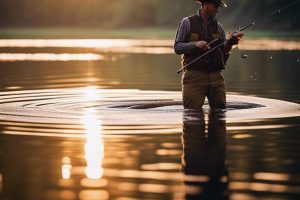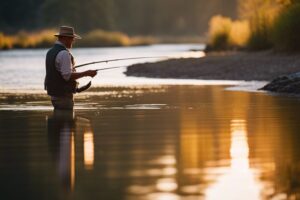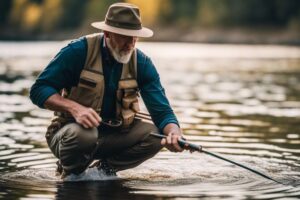Dry flies can be fragile, often succumbing to wear and tear after a few casts. You need techniques that ensure your favorite patterns last longer on the water. By choosing the right materials and applying simple treatments, you can enhance the strength and resilience of your flies. This guide will equip you with practical strategies for prolonging the life of your dry flies, allowing you to spend more time fishing and less time tying replacements.
Material Selection
A careful selection of materials is crucial in improving the durability of your dry flies. Start with the hooks. The choice of hook can impact not only the longevity of your flies but also their performance on the water. You want hooks made from high-carbon steel, which is known for its strength and resistance to bending. A barbless design can also prolong the life of your fly, ensuring that the hook doesn’t damage the fly body as it’s cast and retrieved. Opt for hooks with a good finish that resist rusting, like those coated with a black nickel or bronzed finish. These features combine to give you a hook that withstands the elements and retains its sharpness longer, helping you land more fish without constantly replacing flies.
Choosing the Right Hooks
Material differences among hooks can be subtle, but they make a significant impact on durability. Consider the size and wire gauge as well. Thicker wire hooks are typically more robust and can better handle larger fish without deforming. However, they might sink too deeply in certain situations. Strive for a balance that suits the type of fishing you do. For delicate presentations, opt for light wire; for tougher battles, choose a heavier option. Be mindful that quality tools in your fly boxes mean fewer replacements in the long run, ultimately enhancing your fishing experience.
Durable Thread Options
On to thread selection, as this is another cornerstone in fly durability. Not all threads are created equal. Look for threads that offer both strength and flexibility. Poly and nylon threads are excellent choices as they resist fraying and wear. Ensure that your thread can hold up under tension during tying and while casting. A thread that can withstand both the materials you use and the stresses of fishing will keep your flies intact longer, landing you more catches and requiring fewer replacements.
To add resilience, consider using bonded threads, which have a unique construction that enhances strength. This type of thread allows you to create tight, solid wraps, necessary for securing materials efficiently. You can also find threads that feature expanded thickness, providing extra durability without adding unnecessary bulk. Ultimately, investing in some stronger, high-quality threads will elevate the lifespan of your flies, making your fishing trips more productive and enjoyable.
Body Construction
Clearly, the body construction of your dry flies plays a pivotal role in their durability. The materials you choose and the techniques you employ can make the difference between a fly that lasts through several fish and one that falls apart after a few casts. Focusing on a strong yet appealing body can significantly enhance the lifespan of your flies, giving you more time on the water and less time retying. A durable body not only withstands the wear and tear of the environment but also mimics the aquatic insects you aim to imitate, ensuring better performance.
Using Synthetic Materials
Construction of your fly body using synthetic materials can greatly increase its durability. Synthetic fibers, such as polyethylene or nylon, offer superior resistance to moisture and abrasion compared to natural materials. These fibers tend to retain their shape and color longer, which means your fly will maintain its attractiveness to trout even after repetitive use in tough conditions. You may also find that synthetic materials are lighter, allowing for better buoyancy on the water’s surface.
Reinforcing the Body with Wire
On the other hand, using wire to reinforce your fly body can provide the strength needed to tackle the most robust fish. A simple wire ribbing or even a full wire body can add significant durability and weight, improving your fly’s sink rate and action in the water. This added weight can also help you fish deeper, making your patterns more versatile. When applying wire, be mindful of the gauge; a thicker wire can provide more strength but may also affect the overall aesthetics of your fly.
Wire is not just for reinforcement; it can also help create a segmented look, mimicking the natural profiles of insects. By wrapping wire tightly around your body material, you can create texture and enhance the visual appeal of your fly. This implementation not only fortifies the structure but also introduces a reflective quality that catches the eye of fish. Using wire wisely can transform your dry flies into more durable, effective tools in your angling arsenal.
Wing Creation
One of the key factors in enhancing the durability of your dry flies is the careful consideration of wing creation. The wings not only provide the visual appeal necessary for attracting fish but also play a crucial role in buoyancy and presentation. When dicking out materials and techniques, it’s crucial to understand how they impact the overall lifespan of your flies. For foundational knowledge, you may want to explore the Dry-fly Fishing Basics to get a sense of the material options available. A durable fly starts with the right components, particularly the wings.
Selecting Long-Lasting Wing Materials
For your dry flies to withstand the rigors of casting and repeated fish encounters, the selection of wing materials is paramount. Opt for synthetic materials like nylon or polypropylene that offer both durability and resistance to water absorption. These materials tend to hold their shape better than natural fibers, which can become soggy and lose effectiveness over time. Additionally, consider using materials with a natural sheen to mimic the reflective quality of living insects, enhancing the fly’s attractiveness while ensuring longevity.
Moreover, blending synthetic and natural materials can yield impressive results. Experiment with combinations of CDC (cul de canard) for flotation and high-tenacity synthetic fibers for added strength. Combining properties of various materials can create a perfect balance of durability and visual appeal that will keep your flies performing on the water.
Techniques for Secure Wing Attachment
Techniques for attaching wings securely can significantly influence your fly’s lifespan. A well-attached wing prevents detachment during casting and fighting fish, which is often a common cause of fly failure. Pay special attention to the placement and the number of wraps you make around the base of the wings. Using a figure-eight technique can help lock them in place, especially if you plan to use materials that might otherwise slide out of position.
Secure your wings with tight thread wraps, beginning at the base and working your way outwards. This method not only secures the material but also helps to shape the wings into a desirable profile. Adjust the angle of the wings as you work to ensure they are positioned correctly, which contributes both to the fly’s aerodynamics and its attractiveness in the water. The more secure your wings, the longer your flies will last, allowing you to spend more time on the water and less time in your tying bench.
Hackle Management
Once again, you must pay attention to the hackle when tying your dry flies. Proper hackle management is pivotal for ensuring durability. The right hackle not only provides flotation but also enhances the fly’s overall functionality. When selecting your materials, choose feathers that are robust and resilient. Qualities like stiff barbs and a consistent stem will contribute to a hackle that withstands aggressive strikes from fish and the rigors of casting.
Preparing Hackle for Durability
An effective way to prepare your hackle is to preen the barbs and ensure they are separated evenly. This process involves gently pulling the barbs apart to create a more uniform appearance. A tidy hackle leads to better presentation on the water, while also adding durability to your fly. Further, you should consider treating the hackle with a little silicone or floatant before tying it in. This added layer of protection not only helps keep your fly buoyant but also aids in preventing wear and tear during usage.
Securing Hackle with Thread and Glue
Management of hackle ties is crucial for the life of your dry fly. You need to secure the hackle tightly using well-placed thread wraps and consider applying a dab of glue to hold it in place. This dual method ensures that even the most active fish cannot dislodge your hackle during those aggressive strikes. The combination of sturdy thread wraps and glue creates a solid foundation that prevents the hackle from loosening, which can often lead to fly failure.
Durability is further enhanced by ensuring that your thread wraps are evenly spaced and properly tensioned. Inconsistent or loose wraps can weaken the connection between the hackle and the fly body, allowing for unwanted movement or, worse, dislodging. By adhering carefully to these principles in hackle management, your dry flies will not only look better but will also endure longer on the water, giving you the confidence to face any fishing adventure that comes your way.
Head Cementing
All fly anglers understand the wear and tear that comes with time. Your dry flies encounter water, wind, and fish, which can lead to degradation. One effective way to enhance the durability of your flies is through proper head cementing. This technique not only secures the thread wraps but also provides a protective layer that can withstand the elements, keeping your flies in top condition for those crucial fishing moments.
Importance of Proper Head Cementing
One of the most critical aspects of fly tying is the application of head cement. This seemingly small detail can significantly alter the lifespan of your flies. Proper head cementing protects the delicate materials you’ve painstakingly selected, creating a barrier against water saturation and physical wear. By ensuring your fly has a well-sealed head, you prevent thread unraveling and material slippage that can compromise your tackle on the water.
Moreover, head cement serves to bond the components of your fly together, reinforcing the overall structure. This added strength translates to greater confidence when casting your flies, knowing they can handle the occasional snag or aggressive strike. The right application method will yield long-lasting results, ensuring that you can return to your favorite fishing spots with reliable gear in hand.
Techniques for Applying Head Cement
With a variety of head cement products available, selecting the right one is just the start. The technique of application makes the real difference. Begin with a clean, dry head to ensure proper adhesion. Use a fine brush or applicator for precise application, taking care not to apply too much at once. A thin layer is often more effective, as it seeps into the wraps without oversaturating the materials.
Cementing properly takes practice. Apply the cement sparingly, allowing it to settle into the thread wraps. It’s often wise to start at the back of the head and work your way forward. This approaches ensures even coverage and helps you avoid pooling. Once you’ve applied the cement, allow it to cure fully. Proper curing time is crucial; even the best cement will fail if not given the chance to set. The result will be a sturdier, longer-lasting dry fly ready to tackle whatever the water throws at you.
Finishing Touches
Unlike other aspects of fly tying, the finishing touches are what can truly enhance the longevity and effectiveness of your dry flies. When you’ve dedicated time and effort to crafting your patterns, it’s worth ensuring they endure the test of time on the water. One way to elevate your flies is to incorporate a few simple techniques. If you want to know more about maintaining their buoyancy, check out this thread on How do you keep dry flies, well, dry?.
Adding a Protective Coating
Adding a protective coating to your dry flies can significantly increase their durability. Consider using a product specifically designed for fly tying, such as a Fleximent or a UV resin. A thin layer applied to the entire fly can help seal the materials, making them less susceptible to water absorption and wear from casting. This simple approach not only enhances the longevity of the fly but helps maintain its original shape and buoyancy.
Moreover, these coatings can add an extra sheen that may attract fish. Applying this finish is often as easy as dipping or brushing and allows your creativity to shine. Ensure the coating is dry and secure before you hit the water, as a well-finished fly is a testament to your dedication as an angler.
Inspecting and Repairing Flies
The moment of truth comes when you pull your flies from the box before a fishing trip. Inspect them closely; this simple step can save you from lost fishing time. Check for frayed threads, damaged wings, or missing materials. A well-maintained fly will outlast your trip, while a neglected one can fail at the worst possible moment.
Flies often experience wear and tear, especially after multiple uses. If you spot any damages, don’t hesitate to make repairs. A few quick fixes, like replacing wings or re-tying hackles, can breathe new life into your tired flies. As you familiarize yourself with the common signs of wear, you’ll become more adept at maintaining your arsenal, ensuring every fishing trip is a success. Keep in mind, a little attention goes a long way in extending the lifespan of your dry flies.
Summing Up
Taking this into account, you can significantly enhance the longevity of your dry flies with a few thoughtful techniques. Using materials like foam or synthetic fibers will not only keep your flies buoyant but also resistant to wear and tear from repeated strikes. Additionally, treating your flies with desiccants or floatant will help maintain their water-repelling properties, giving you the confidence to confidently cast them again and again. Bear in mind, durability doesn’t have to come at the expense of effectiveness; your carefully crafted flies can withstand the elements while still attracting fish.
By taking these steps, you ensure that your investment in time and materials pays off in the long run. Consider making your routine checks for wear and tear part of your fly-fishing preparation. A little maintenance goes a long way in preserving your flies. With these practices, you’ll not only enjoy a more successful fishing experience but also cultivate a deeper connection to the art of fly tying and fishing. In the end, the quality of your catch lies in the resilience of your flies.
FAQ
Q: What materials can I use to enhance the durability of my dry flies?
A: To improve the durability of your dry flies, consider using synthetic materials such as foam, poly yarn, or Antron for the body and wings. These materials are less prone to absorbing water and are more resistant to wear and tear compared to natural fibers. Additionally, using a strong, abrasion-resistant thread can help ensure that your flies hold up during casting and encounters with fish. Coating your fly with a waterproofing solution can also help protect it from the elements and prolong its lifespan.
Q: How can I reinforce the construction of my dry flies to prevent them from falling apart?
A: To reinforce the construction of your dry flies, be mindful of your tying techniques. Use multiple wraps of thread when securing materials, especially in high-stress areas like the wing and tail. Consider using a whip finish knot to secure the head of the fly more tightly. Additionally, incorporating techniques such as using a double or triple layer of material for wings can add strength. Applying a thin coat of head cement or UV resin to the thread wraps can also help lock everything in place and provide extra durability.
Q: Are there specific environmental factors that can affect the durability of dry flies, and how can I mitigate these effects?
A: Yes, environmental factors such as UV exposure, water temperature, and abrasive surfaces can impact the durability of dry flies. To mitigate these effects, store your flies in a protective container that blocks UV light when not in use. Avoid fishing in areas with rough terrain or abundant underwater structures that could damage your flies. Lastly, periodically inspect your flies for signs of wear and tear while fishing, and replace them as needed to maintain your equipment’s effectiveness.


